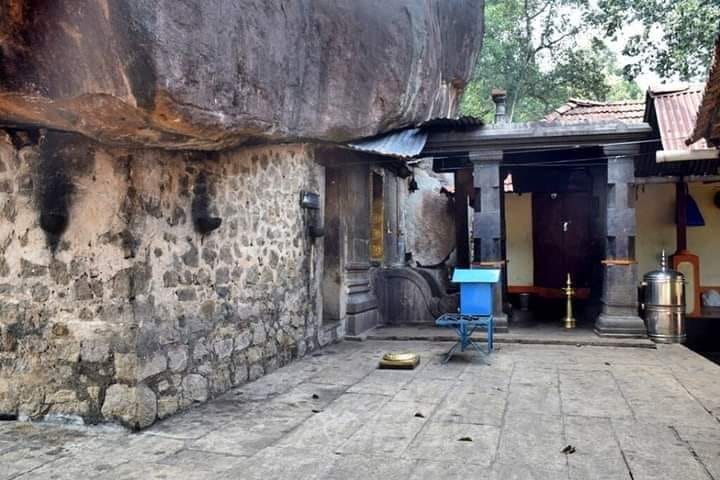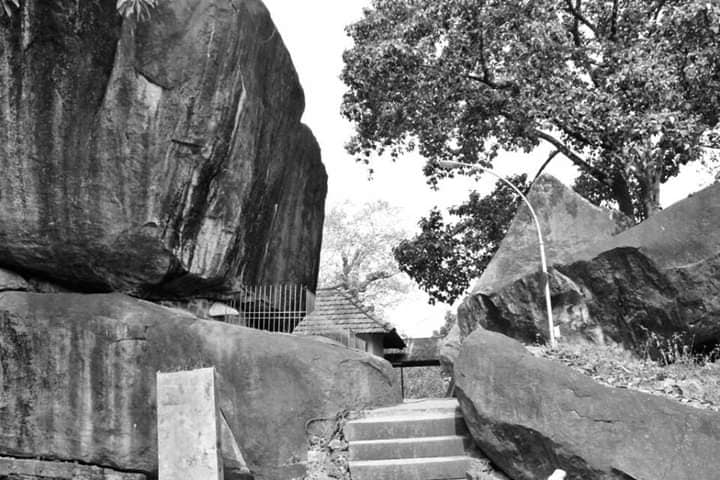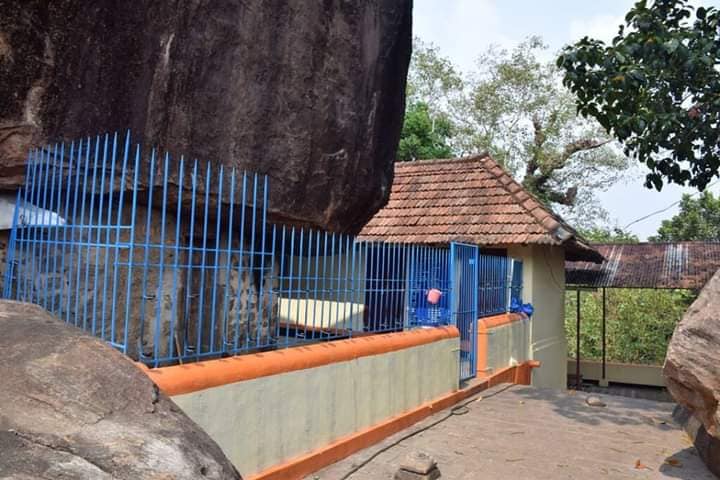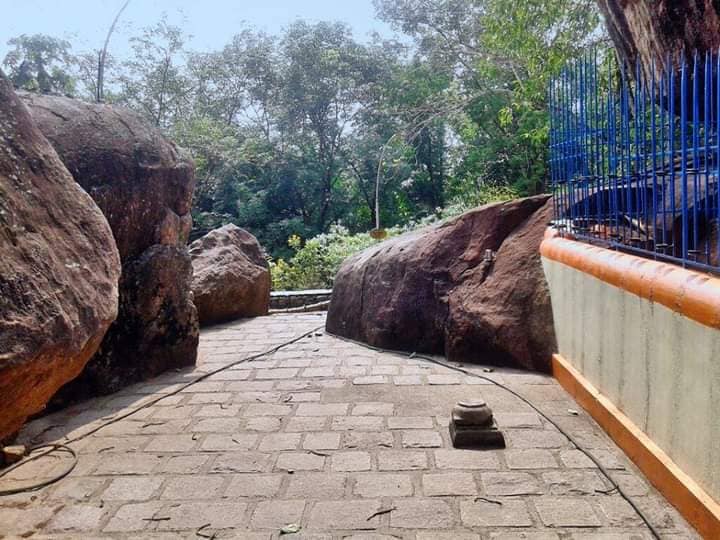Kallil Temple is a historic Hindu-Jain temple located in Kerala, South India. Situated 8 km from Perumbavoor in Ernakulam district of Kerala.

Kallil Temple, meaning "in stone" in Malayalam, is one of the most ancient Hindu temples in Kerala. Recognized as a protected monument under the Kerala State Department of Archaeology, the temple is carved from a massive rock and is situated on a 28-acre (113,000 m²) site. Visitors must climb 69 steps to reach the temple.
Located about 2 km from Odakkali on the Aluva-Munnar Road and 10 km from Perumbavoor, the temple is historically owned by the Kallil Pisharody family. While the administrative control was once handed over to 'Chenkottukonam Sree Ramadasashramam,' it was later reclaimed due to disputes between the local community and the Ashram authorities.
The history of Kallil Temple is closely associated with Jainism. It is believed that the temple was originally a Jain shrine in its early days. The presiding deity, Bhagavathi, is thought to be a form of Padmavati, the Yakshini (female attendant deity) of Jainism. According to historical accounts, the temple transitioned from a Jain place of worship to a Bhagavathi temple around the 9th century.
A fascinating legend is linked to the temple. It is said that long ago, people wandering through the forest saw a woman of extraordinary beauty. As they approached her, she mysteriously vanished while playing with stones.
She was believed to have hidden inside a cave along with the stones she played with. This woman is believed to be the goddess Bhagavathi.
Another part of the legend suggests that the large rock above the temple became its roof when the goddess lifted it while playing. The same rock then descended to form the temple’s seat. Even today, the massive rock that serves as the shrine's roof does not touch the ground. It is said that even if 15 elephants pull it together, the rock will not move!
The two most significant vows at Kallil Temple are the Stone Vow and the Broom Vow. The Broom Vow is observed by women seeking hair growth and by men wishing to resolve family troubles; a broom made of wool, without touching iron, is offered at the temple. The Stone Vow is believed to help complete unfinished house construction—devotees bring two or three stones from the construction site to the temple, pray, and it is believed that the work will be completed within a year. Those who receive blessings return to offer thanks and make new vows in gratitude.
The temple festival is celebrated on the Karthika day in the month of Vrishchika (Scorpio) and lasts for eight days. Traditionally, the temple remained open for devotees to walk after the noon pooja due to the difficulty of returning later for evening rituals. However, while the walk is now closed after the noon pooja, it reopens for evening devotional offerings and Athazha pooja.
The temple houses rock-carved images of the 23rd Tirthankara Parshvanatha, the 24th Tirthankara Vardhaman Mahavira, and Padmavati Devi, who is worshipped locally as Bhagavathi. The temple’s major festival, celebrated from Karthika in the month of Vrishchika, usually lasts for a week.
കല്ലിൽ ഭഗവതി ക്ഷേത്രം
എറണാകുളം ജില്ലയിലെ പെരുമ്പാവൂരിനടുത്ത് മേതല ഗ്രാമത്തിലാണ് കല്ലിൽ ഭഗവതി ക്ഷേത്രം സ്ഥിതി ചെയ്യുന്നത്. ഒമ്പതാം നൂറ്റാണ്ടിൽ സ്ഥാപിതമായ ഈ ക്ഷേത്രം ആരംഭത്തിൽ ജൈന ക്ഷേത്രമായിരുന്നെന്നാണ് വിശ്വാസം. കേരളത്തിലെ ഏറ്റവും പുരാതന ഹിന്ദു ക്ഷേത്രങ്ങളിൽ ഒന്നായ ഇത് 28 ഏക്കർ വിസ്തീർണ്ണമുള്ള കാടിനകത്താണ് സ്ഥിതിചെയ്യുന്നത്.
ഒരു വലിയ പാറയുടെ മുകളിൽ കൽപ്പിച്ച ഈ ക്ഷേത്രത്തിലേക്ക് എത്തുന്നതിന് 120 പടികൾ കയറേണ്ടതുണ്ട്. പെരുമ്പാവൂരിൽ നിന്ന് 10 കിലോമീറ്റർ ദൂരത്തിലാണ് ഇത് സ്ഥിതിചെയ്യുന്നത്. ആദ്യകാലത്ത് കല്ലിൽ പിഷാരോടി കുടുംബത്തിന്റെ ഉടമസ്ഥതയിലുണ്ടായിരുന്ന ഈ ക്ഷേത്രം ഇപ്പോൾ പിഷാരത്ത് ദേവസ്വത്തിന്റെ കീഴിൽ പ്രവർത്തിക്കുന്നു. കേരള സംസ്ഥാന പുരാവസ്തു വകുപ്പിന്റെ സംരക്ഷിത സ്മാരകങ്ങളിൽ ഒന്നായി ഈ ക്ഷേത്രം ഉള്പ്പെടുത്തപ്പെട്ടിരിക്കുന്നു.
28 ഏക്കർ (113,000 ചതുരശ്ര മീറ്റർ) വിസ്തൃതിയുള്ള ഈ ക്ഷേത്രം ഒരു വലിയ പാറയിൽ നിന്ന് രൂപകൽപ്പന ചെയ്തതാണ്. ക്ഷേത്രത്തിലെത്തുന്നതിനായി 69 പടികൾ കയറേണ്ടതുണ്ടു. ഓടക്കാലിയിൽ നിന്ന് ആലുവ-മൂന്നാർ റോഡിലൂടെയും പെരുമ്പാവൂരിൽ നിന്ന് 10 കിലോമീറ്റർ സഞ്ചരിച്ചും ഇവിടെ എത്താം. മുമ്പ് ഈ ക്ഷേത്രം ഒരു തറവാട്ടിന്റെ ഉടമസ്ഥതയിലായിരുന്നു, എന്നാൽ പിന്നീട് ക്ഷേത്രത്തിന്റെ ഭരണനിയന്ത്രണവും അതിന്റെ എല്ലാ വസ്തുക്കളും ചെങ്കോട്ടുകോണം ശ്രീരാമദാസാശ്രമത്തിന് കൈമാറി.
എന്നാൽ, നാട്ടുകാരും ആശ്രമ ഭരണസമിതിയും തമ്മിലുണ്ടായ ചില പ്രശ്നങ്ങൾ കാരണം ഈ ഉടമസ്ഥാവകാശം പിന്നീട് തിരിച്ചെടുത്തു. "കല്ല്" എന്ന പദം ആദിദ്രാവിഡ ഭാഷയിൽ നിന്നുള്ളതാണ്. "കല്ല് + ഇൽ" എന്ന സമാസത്തിലൂടെ "കല്ലിൽ" എന്ന പദമുണ്ടായി. കുഴിക്കുക, മാളമുണ്ടാക്കുക എന്നീ അർത്ഥങ്ങളുള്ള ഈ പദത്തിൽ നിന്ന് കല്ലിൽ ക്ഷേത്രം ഒരു ഗുഹാക്ഷേത്രമാണെന്ന ഉദ്ദേശ്യം വ്യക്തമാകുന്നു.
ക്ഷേത്രത്തിന്റെ കവാടം കടക്കുമ്പോൾ പാറകളാൽ നിറഞ്ഞ വഴിയും ചെറിയ കാടുകളും കാണാം.
മുകളിലേയ്ക്ക് കയറുന്തോറും വലിയ പാറക്കല്ലുകൾ കൂടുതൽ വ്യക്തമായി ദൃശ്യമായി വരുന്നു. ക്ഷേത്രത്തിന്റെ ശ്രീകോവിലിലേക്കുള്ള പടികൾ മുഴുവനായും കരിങ്കല്ലിൽ നിർമിച്ചിട്ടുള്ളതാണ്. പടികൾ കയറുമ്പോൾ കാണുന്ന ആനപ്പന്തലിന്റെ കരിങ്കല്ലിൽ തീർത്ത തൂണുകൾ ഭക്തരെയത്രയും അത്ഭുതപ്പെടുത്തുന്നു! പ്രദക്ഷിണ വഴിയിലും ശ്രീകോവിലിനു മുന്നിലും നിലത്താകെ കല്ലിന്റെ പാളികളാണ്.
ശ്രീകോവിലിനു മുന്നിലുള്ള നമസ്കാരമണ്ഡപം പോലും മേൽക്കൂരയടക്കം മുഴുവനായും കരിങ്കല്ലിൽ നിർമിച്ചിരിക്കുന്നു. ഭഗവതി ഇരുന്നരുളുന്ന ശ്രീകോവിൽ ഒരു വലിയ കല്ലിൽ രൂപം കൊണ്ട ഗുഹയ്ക്കുള്ളിലാണ്. ഗുഹാക്ഷേത്രമായതിനാൽ പതിവ് ക്ഷേത്രങ്ങളിൽ പോലെ ശ്രീകോവിലിന് ചുറ്റും പ്രദക്ഷിണം നടത്താൻ കഴിയില്ല. ഭക്തർ ഭഗവതിയെ പ്രദക്ഷിണം വയ്ക്കുമ്പോൾ ക്ഷേത്രം നിർമ്മിതമായിരിക്കുന്ന വലിയ പാറയെയും കൂടിയാണ് വലയം ചെയ്യുന്നത്.
പ്രദക്ഷിണ വഴികളിലും കല്ലിൽ തീർത്ത പടവുകളും ചെറു ഗുഹകളും കാലങ്ങളായി ദേവിയുടെ പാദസേവ ചെയ്ത് നിലകൊള്ളുന്ന വേരുകളും കാണാം. ഈ രീതിയിൽ, അക്ഷരാർത്ഥത്തിൽ 'കല്ലിൽ' അരുളുന്ന ദേവിയെ ഇവിടെ സന്ദർശിക്കുമ്പോൾ അനുഭവിക്കാനാകും! കല്ലിൽ ക്ഷേത്രം ആര്യാധിപത്യത്തിന് മുമ്പ് പ്രശസ്തമായ ജൈന ഗുഹാക്ഷേത്രമായിരുന്നു. പിന്നീട് ബ്രാഹ്മണാധിപത്യകാലത്ത് പ്രതിഷ്ഠയും സങ്കല്പങ്ങളും ബ്രാഹ്മണീകരിച്ചു. ഗുഹാക്ഷേത്രങ്ങളുടെ ഉത്ഭവം ജൈനമതത്തിന്റെ കാലത്താണ്. ഈ ക്ഷേത്രത്തിലെ പ്രധാന പ്രതിഷ്ഠ ദുർഗ്ഗയാണ്.
ഒരു പാറ തുരന്നുണ്ടാക്കിയ ഗുഹയിലാണ് ഭഗവതിയുടെ പ്രതിഷ്ഠ. വിഗ്രഹം പഞ്ചലോഹംകവചം കൊണ്ടു മൂടിയിരിക്കുന്നു. യഥാർത്ഥത്തിൽ ഇത് ജൈനമതത്തിലെ യക്ഷിയായ പദ്മാവതിയുടെ വിഗ്രഹമാണെന്ന് വിശ്വസിക്കപ്പെടുന്നു.
പാറമലയ്ക്ക് മുകളിൽ ബ്രഹ്മാവിന്റെ വിഗ്രഹം കൊത്തിയുണ്ടാക്കിയിരിക്കുന്നു. ശിവനും വിഷ്ണുവും ബ്രഹ്മാവിനൊപ്പമാണെന്ന സങ്കല്പം ഉള്ളതിനാൽ, ഇവിടം ശിവനും വിഷ്ണുവിനും ബ്രഹ്മാവിനും സമാനമായി ആരാധന നടത്തുന്നു. ഇത്തരത്തിൽ, ഈ വിഗ്രഹങ്ങൾ യഥാർത്ഥത്തിൽ ജൈനമതത്തിലെ പാർശ്വനാഥന്റേയും മഹാവീരന്റേയും വിഗ്രഹങ്ങളായിരുന്നു എന്നാണ് കരുതപ്പെടുന്നത്.
ക്ഷേത്രത്തിൽ ഗണപതി, ശാസ്താവ്, കരിനാഗയക്ഷി എന്നിവരുടെ സാന്നിദ്ധ്യവും ഉണ്ടെന്ന് വിശ്വസിക്കപ്പെടുന്നു. വലിയമ്പലത്തിന് പുറത്ത് വടക്കുകിഴക്ക് മൂലയിലായി പടിഞ്ഞാറോട്ടുള്ള ദർശനത്തിൽ ഒമ്പത് പ്രതിഷ്ഠകളുണ്ട്. അടുത്ത കാലം വരെയും ഉച്ചപൂജയോടെ പൂജകൾ അവസാനിച്ച് മദ്ധ്യാഹ്നത്തോടെ നടയടയ്ക്കുന്ന പതിവ് തുടരുകയുണ്ടായി. കാടിന്റെ നടുവിലുള്ള ഈ ക്ഷേത്രത്തിൽ മേൽശാന്തിക്ക് രാത്രികാലങ്ങളിൽ പൂജകൾ നിർവഹിക്കുന്നത് പ്രയാസകരമായിരുന്നുവെന്നും അതിനാൽ ഈ രീതി ആവിഷ്കരിച്ചിരുന്നെന്നും കരുതപ്പെടുന്നു.
അന്നാളുകളിൽ സന്ധ്യാ പൂജകൾ കല്ലിൽ ഷാരത്തിൽ തന്നെ നടത്തപ്പെട്ടിരുന്നു. എന്നാൽ ഏതാനും വർഷങ്ങളായി ഉച്ചപൂജയ്ക്ക് ശേഷം നടയടയ്ക്കുന്ന ക്ഷേത്രം സന്ധ്യയോടെ ദീപാരാധനയ്ക്കായി വീണ്ടും തുറക്കുന്നു. അത്താഴപൂജയ്ക്കു ശേഷം രാത്രി 7:30ഓടെ പൂജകൾ അവസാനിപ്പിച്ച് നടയടയ്ക്കുന്നു.
ഇത്തരത്തിലൊരു പൂജാക്രമം നിലവിൽ വരുന്നതിനു മുമ്പ്, വൃശ്ചിക മാസത്തിലെ കാർത്തിക നാളിൽ കൊടിയേറും തൃക്കാർത്തിക മഹോത്സവത്തിൻ്റെ ദിവസങ്ങളിൽ മാത്രമേ ദീപാരാധന തുടങ്ങിയ സായാഹ്ന പൂജകൾ പതിവായിരുന്നുള്ളൂ.
ക്ഷേത്രത്തിൽ "ഇടിതൊഴൽ" എന്നൊരു പ്രത്യേക വഴിപാടുണ്ട്. വ്രതം അനുഷ്ഠിച്ച മാരാർ വാദ്യമേളങ്ങളോടെ ഉണക്കലരി, വെറ്റില, പാക്ക്, ചുണ്ണാമ്പ്, മഞ്ഞൾ എന്നിവ ഉരലിൽ ഇട്ട് ഇടിച്ച് തയ്യാറാക്കിയ കൂട്ട് ദേവിക്ക് സമർപ്പിച്ച്, ഭക്തജനങ്ങൾക്ക് പ്രസാദമായി വിതരണം ചെയ്യുന്നു.
ഈ വഴിപാടു വൃശ്ചിക മാസത്തിലെ കാർത്തിക നാളിൽ മാത്രമേ വർഷത്തിലൊരിക്കൽ നടത്തപ്പെടാറുള്ളൂ.
Address:
Pulluvazhi Kallil Rd,
Methala,
Perumbavoor, Kerala 683545



